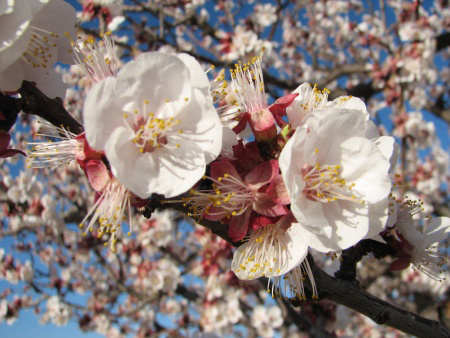
As with all fruit-bearing trees, it is extremely important to keep apricot trees pruned correctly. By thinning these trees out and making sure they grow in the correct shape, gardeners can help them produce large fruits every year. Here are some tips to remember about pruning apricot trees.
When to Prune Apricot Trees
Just like cherry trees and other stone fruits, apricot trees are best to prune in the summer. They should never be pruned in the winter or on damp days because these trees are very susceptible to water-borne diseases. Pruning apricot trees in the winter prevents the cuts from healing correctly on the tree, leaving them open to dangerous diseases when rainy weather comes. Pruning in dry, warm weather is best to ensure a healthy tree.
Long-Term Shape
Most gardeners are intimidated when it comes to pruning a fruit-bearing tree. However, the goal of pruning these trees is to have a long-term shape already in mind. There are a number of different shapes that work well for apricot trees, but one of the most common is known as the Modified Central Leader. This shape better protects the fruit from sun damage.
How to Prune an Apricot Tree
Apricot trees should first be pruned when they are still young. This is the best way to train these trees to grow into the shape the gardener wants. Below is a more detailed breakdown of how to prune an apricot tree.
What branches to cut: The first of the scaffold branches should start at around 18 to 24 inches above the ground. Branches any lower should be pruned. Scaffold branches are the primary limbs that grow from the truck of the tree.
Angles of branches: Gardeners need to look for strong branches that are growing at around 45 to 60-degree angles. These are the branches they want to cultivate instead of pruning. Other branches should be thinned out to make room for these to grow. If there are not enough branches growing at these angles, gardeners can find well-placed branches and create wooden support devices to help the branch learn to grow at the desired angle.
Branch placement: When thinning out branches, look for branches that do not overlap. The best-case scenario would see branches going up the tree at 12, 3, 6 and 9 o’clock. The vertical distance between these branches should be around 8 to 10 inches apart.
Heading Cuts
After the main pruning has been done, it will be time to make heading cuts. These are cuts that remove only part of a branch and not the whole thing. All branches should be cut to a length of around 6 inches if they are not scaffolding branches. Gardeners should become accustomed to picking out scaffolding branches so that they can easily prune the other branches. The reason why these heading cuts are important is because it helps to stimulate the growth of fruit-bearing branches.
Removing Dead Branches and Discolored Leaves
As the tree starts to grow, the main goal of pruning is to remove dead branches and leaves that are becoming discolored. Dead branches sap resources from the tree even though they are unable to use the resources they take. As these branches are noticed, gardeners should remove them at once; however, they should not be removed during winter or rainy days because this can still lead to diseases despite the fact that it is already a dead limb. Dead limbs are still attached to a living tree, and the disease can enter into the tree at the spot of any cut. Taking precautions when pruning can ensure that a gardener raises a healthy, thriving tree.
Photo courtesy of Colorado Tree Coalition
